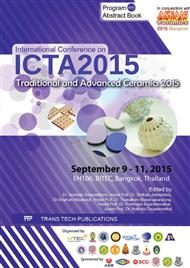[1]
P. Wasuwanich, C. Kuentag, Clay Deposits of Thailand, Conference on Geology and Mineral Resources of Thailand, Department of Mineral Resources, Bangkok, November 19-28, 1983, pp.220-225.
Google Scholar
[2]
C. Hinthong, Environmental geology – a thematic map for land-use planning in the Lampang area, Northern Thailand, Proceedings of the National Conference on Geologic Resources of Thailand – Potential for Future Development, (1992) 368–382.
Google Scholar
[3]
Department of Mineral Resources, The Geology and Mineral Resources Status Report, (2014).
Google Scholar
[4]
Lampang Provincial Office, The Lampang Province Summary Report, (2014).
Google Scholar
[5]
Department of Mineral Resources, The Mineral Resources Map of Lampang Province, (2007).
Google Scholar
[6]
A. Jaitabutr, Non-Metal Resources Assessment in the Northern of Thailand, Department of Mineral Resources, (2010).
Google Scholar
[7]
American National Standard. 2005. ASTM C 325 – 81 Standard Test Method for Wet Sieve Analysis of Ceramic Whiteware Clays.
Google Scholar
[8]
American National Standard. 2005. ASTM C 371 – 89 Standard Test Method for Wire-Cloth Sieve Analysis of Non-plastic Ceramic Powders.
Google Scholar
[9]
American National Standard. 2005. ASTM C 373 – 88 Standard Test Method for Water Absorption, Bulk Density, Apparent Porosity, and Apparent Specific Gravity of Fired Whiteware Products.
DOI: 10.1520/c0373-14
Google Scholar
[10]
American National Standard. 2005. ASTM C 326 – 03 Standard Test Method for Drying and Firing Shrinkage of Ceramic Whiteware Clays.
Google Scholar
[11]
American National Standard. 2005. ASTM C 674-88 Standard Test Methods for Flexural Properties of Ceramic Whiteware Materials.
Google Scholar
[12]
American National Standard. 2005. ASTM C 689-03a Standard Test Method for Modulus of Rupture of Unfired Clays.
Google Scholar
[13]
Meseguer, S., Pardo, F., Jordan, M.M., Sanfeliu, T., González, I., 2010. Ceramic behavior of five Chilean clays which can be used in the manufacture of ceramic tile bodies. Appl. Clay Sci. 47, 372–377.
DOI: 10.1016/j.clay.2009.11.056
Google Scholar
[14]
Lawrence, W.G., Ceramic Science for the Potter, Chilton Book Co., 1972, p.35, 119-120.
Google Scholar
[15]
Fisher P. Some comments on the color of fired clays. Ziegelindustrie Int 1984; 37: 475–83.
Google Scholar
[16]
Manhaes RST, Auler LT, SthelMS, Alexandre J, Mas-sunagaMSO, Carrio JG, et al. Soil characterization using X-ray diffraction, photoacoustic spectroscopy and electron paramagnetic resonance. Appl Clay Sci. 2002; 21: 303–11.
DOI: 10.1016/s0169-1317(02)00092-3
Google Scholar
[17]
Baccour, H., Medhioub, M., Jamoussi, F., Mhiri, T., Daoud, A., 2008. Mineralogical evaluation and industrial applications of the Triassic clay deposits, Southern Tunisia. Mater. Characterization 59, 1613–1622.
DOI: 10.1016/j.matchar.2008.02.008
Google Scholar
[18]
Baccour, H., Medhioub, M., Jamoussi, F., Mhiri, T., 2009. Influence of firing temperature on the ceramic properties of Triassic clays from Tunisia. J. Mater. Process. Technol. 209, 2812–2817.
DOI: 10.1016/j.jmatprotec.2008.06.055
Google Scholar
[19]
Monteiro, S.N., Vieira, C.M.F., 2004. Influence of firing temperature on the ceramic properties of clays from Campos dos Goytacazes, Brazil. Appl. Clay Sci. 27, 229–234.
DOI: 10.1016/j.clay.2004.03.002
Google Scholar
[20]
Correia, S.L., Hotza, D., Segadães, A.M., 2004. Simultaneous optimization of linear firing shrinkage and water absorption of triaxial ceramic bodies using experiments design. Ceramics Int. 30, 917–922.
DOI: 10.1016/j.ceramint.2003.10.013
Google Scholar


